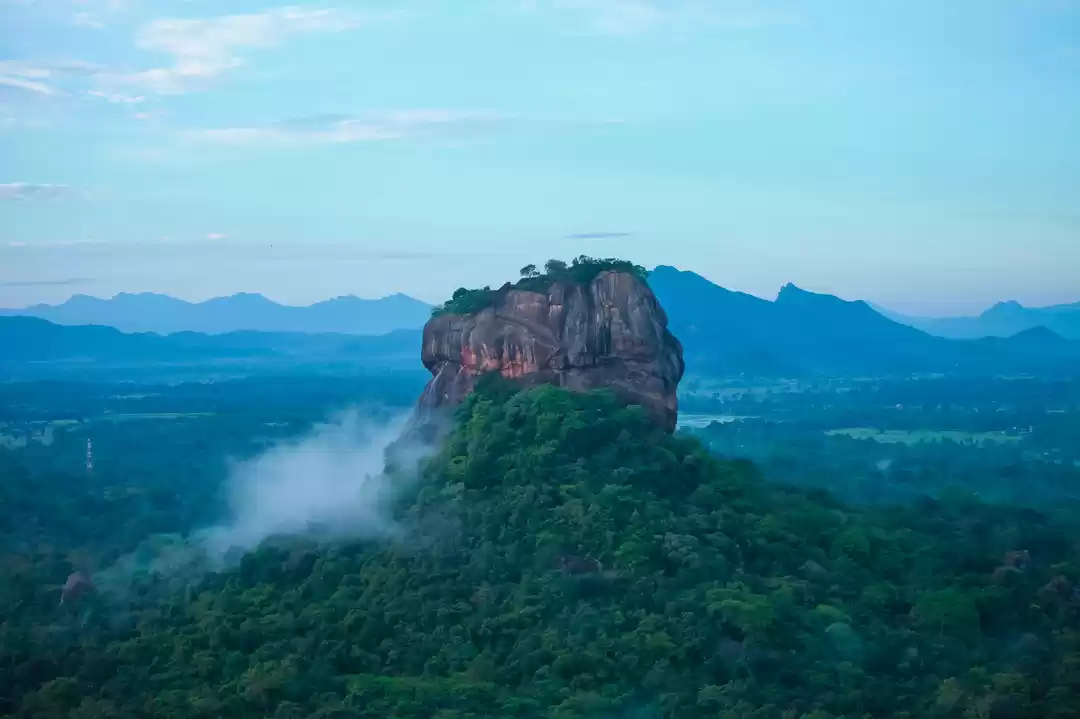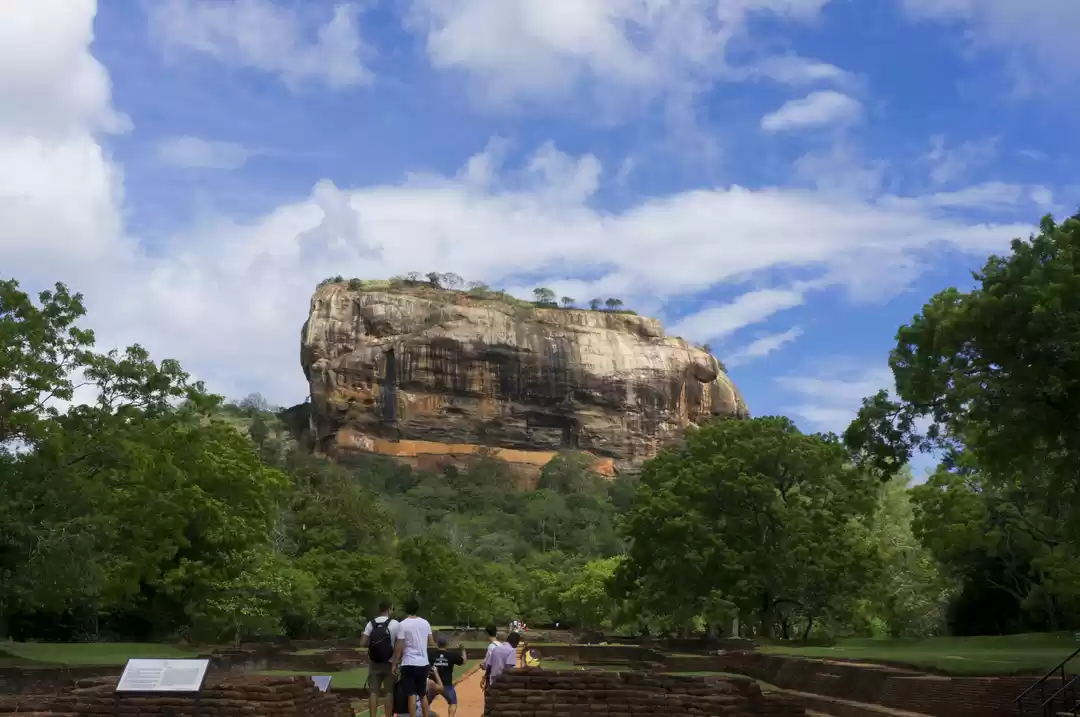Have you ever wondered what it would be like to visit a fortress built on top of a giant rock that resembles a lion’s head? If so, you might want to add Sigiriya Lion Rock to your bucket list. Sigiriya Lion Rock is one of the most impressive and mysterious ancient sites in Sri Lanka, and a UNESCO World Heritage Site that attracts millions of visitors every year. In this article, we will explore the history, architecture, and art of Sigiriya Lion Rock, and discover some of the secrets and legends that surround this magnificent fortress. We will argue that Sigiriya Lion Rock is not only a remarkable example of ancient engineering and creativity, but also a symbol of the cultural and political identity of Sri Lanka and its people.
How and why was Sigiriya Lion Rock built?

Sigiriya Lion Rock was built in the 5th century CE by King Kashyapa, who usurped the throne from his father and his half-brother Moggallana. To escape from the threat of his brother’s revenge, Kashyapa decided to move his capital from Anuradhapura to Sigiriya, a massive rock that rose 200 meters above the surrounding jungle. He transformed the rock into a fortified palace, with elaborate water gardens, a mirror wall, a lion gate, and a summit complex. He also commissioned hundreds of frescoes to adorn the rock walls, depicting beautiful women who are believed to be his consorts, celestial nymphs, or goddesses.
Kashyapa’s motivation for building Sigiriya Lion Rock was not only to ensure his security, but also to assert his legitimacy and authority. He wanted to create a monument that would rival the mythical abode of the gods, Mount Meru, and demonstrate his power and glory. He also wanted to express his devotion and affiliation to the cult of the lion, which was associated with the origin and identity of the Sinhalese people. According to legend, the Sinhalese are descended from the union of a lion and a princess, and their name means “lion people” in Sanskrit. By building Sigiriya Lion Rock, Kashyapa was claiming his right to rule as a lion king.
How and why was Sigiriya Lion Rock abandoned?
Kashyapa’s reign was short-lived, as he was defeated and killed by his brother Moggallana in 495 CE, after a bloody battle at the foot of Sigiriya Lion Rock. Moggallana restored the original capital at Anuradhapura, and Sigiriya Lion Rock was abandoned and neglected for centuries. It was later occupied by Buddhist monks, who used it as a monastery and a pilgrimage site. They also added their own inscriptions and paintings to the mirror wall, which became a repository of ancient graffiti.
Sigiriya Lion Rock was rediscovered by British archaeologists in the 19th century, who were amazed by its beauty and mystery. They began to excavate and restore the site, and revealed its hidden treasures and secrets. Sigiriya Lion Rock was declared a UNESCO World Heritage Site in 1982, and is now one of the most popular tourist attractions in Sri Lanka. It is also a source of pride and inspiration for the Sri Lankan people, who regard it as a symbol of their ancient civilization and heritage.
What are the main features of Sigiriya Lion Rock?
Sigiriya Lion Rock is a masterpiece of ancient engineering and art, that showcases the skill and creativity of its builders and designers. It is divided into several areas and levels, each with its own function and style. The main features of Sigiriya Lion Rock are:
The water gardens: The water gardens are located at the base of the rock, and are composed of pools, fountains, ponds, and canals. They are fed by an ingenious hydraulic system, that uses underground pipes and gravity to supply water from a nearby reservoir. The water gardens are designed to create a pleasant and refreshing environment, and to reflect the beauty of the rock and the sky. They are also symbolic of the cosmic ocean, that surrounds Mount Meru in Hindu mythology.
The mirror wall: The mirror wall is a long wall that runs along the western side of the rock and is made of polished plaster that shines like a mirror. It was originally painted with colourful patterns and designs, but only traces of them remain today. The mirror wall is famous for its graffiti, which are inscriptions and poems written by visitors and pilgrims over the centuries. They express their admiration and awe for Sigiriya Lion Rock and provide valuable insights into the history and culture of Sri Lanka.
The lion gate: The lion gate is the entrance to the summit complex, and is the most iconic feature of Sigiriya Lion Rock. It is shaped like a huge lion, with its paws and claws carved out of the rock, and its head and body made of brick and plaster. The lion gate is a symbol of the power and majesty of King Kashyapa, and his connection to the lion cult. It is also a representation of the guardian of the rock, who protects it from evil and intruders. Visitors have to climb a steep staircase that passes through the lion’s mouth, to reach the top of the rock.
The frescoes: The frescoes are paintings that cover the rock walls, and depict women who are either holding flowers, playing musical instruments, or offering blessings. They are painted with natural pigments, and have a realistic and graceful style. They are considered to be among the finest examples of ancient art in Sri Lanka, and have attracted much attention and controversy. The origin and identity of the women are still debated, as some scholars believe they are Kashyapa’s consorts, others think they are celestial nymphs, and others suggest they are goddesses. The meaning and purpose of the frescoes are also unclear, as some interpret them as a display of Kashyapa’s wealth and pleasure, others see them as a tribute to the fertility and beauty of nature, and others view them as a manifestation of the divine and sacred.
The palace: The palace is the highest and most impressive part of Sigiriya Lion Rock, and is located at the summit of the rock. It consists of several buildings and structures, such as a throne hall, a council chamber, a bathing pool, and a dagoba (a Buddhist stupa). The palace offers spectacular views of the surrounding landscape, and is designed to create a sense of harmony and balance. The palace is the ultimate expression of Kashyapa’s ambition and vision, and his attempt to create a heavenly and royal residence on earth.
What is the cultural and historical value of Sigiriya Lion Rock?
Sigiriya Lion Rock is more than just a stunning site, it is also a cultural and historical treasure that represents and influences the identity and heritage of Sri Lanka and its people. Sigiriya Lion Rock has a high cultural and historical value, because:
It is a UNESCO World Heritage Site, that is recognized and protected for its outstanding universal value, and its contribution to the common heritage of humanity.
It is a source of archaeological, historical, artistic, and engineering knowledge, that reveals the ancient and medieval civilization and culture of Sri Lanka, and its achievements and challenges.
It is a symbol of the Sinhalese culture and identity, that reflects their origin and affiliation to the lion legend, and their resilience and pride in the face of foreign invasions and domination.
It is a tourist attraction and a national icon, that draws visitors and admirers from all over the world, and inspires them to appreciate and respect the beauty and diversity of Sri Lanka and its people.
What are some of the secrets and legends of Sigiriya Lion Rock?
Sigiriya Lion Rock is not only a fascinating site, it is also a mysterious site that hides and sparks many secrets and legends. Some of the secrets and legends of Sigiriya Lion Rock are:
The name Sigiriya, which means “lion rock” in Sinhalese, is derived from the word “Sihagiri”, which means “lion mountain” in Pali, the ancient language of Buddhism. According to legend, the rock was named after the lion that fathered the first Sinhalese king, Vijaya, who arrived in Sri Lanka from India in the 6th century BCE. The lion was said to have lived on the rock, and to have given his son a magic sword and a lion flag, that became the symbols of the Sinhalese kings and people.
The frescoes of Sigiriya Lion Rock are surrounded by mystery and controversy, as their origin and identity are still unknown. One of the most popular theories is that they are portraits of Kashyapa’s 500 wives, who were brought to Sigiriya from different parts of the world. Another theory is that they are images of apsaras, the heavenly nymphs who entertained and served the gods in Hindu mythology. A third theory is that they are depictions of Tara, the female Buddha of compassion and wisdom in Buddhism. The frescoes are also said to have magical powers, that can grant wishes and blessings to those who gaze at them with pure and sincere hearts.
The mirror wall of Sigiriya Lion Rock is cursed, according to some legends. The curse was allegedly cast by Kashyapa himself, who was enraged by the graffiti that defaced his masterpiece. He decreed that anyone who wrote on the wall would die a horrible death, or suffer a terrible fate.
The mirror wall of Sigiriya Lion Rock is cursed, according to some legends. The curse was allegedly cast by Kashyapa himself, who was enraged by the graffiti that defaced his masterpiece. He decreed that anyone who wrote on the wall would die a horrible death, or suffer a terrible fate. The curse is said to have been fulfilled many times, as some of the writers met with accidents, illnesses, or misfortunes. Some of the inscriptions also contain warnings or regrets from the writers, who realized their mistake too late. However, some scholars doubt the authenticity and accuracy of the curse, and suggest that it was a later addition or a fabrication by the monks or the British.
The hidden and undiscovered chambers and tunnels of Sigiriya Lion Rock are a source of speculation and exploration, as they may contain more secrets and treasures of Kashyapa and his kingdom. Some of the chambers and tunnels are visible or accessible, such as the cobra hood cave, the boulder garden, and the lower palace. Others are concealed or blocked, such as the underground palace, the spiral staircase, and the lion’s mouth. Some explorers and adventurers have tried to enter or uncover these chambers and tunnels, but they have faced many obstacles and dangers, such as traps, snakes, bats, and bees. Some believe that these chambers and tunnels hold the key to solving the mysteries of Sigiriya Lion Rock, such as the true identity of the frescoes, the fate of Kashyapa’s treasure, and the purpose of the lion gate.
We hope that this article has given you a glimpse of the wonder and mystery of Sigiriya Lion Rock, and inspired you to visit or learn more about this ancient marvel of Sri Lanka. What do you think is the most fascinating aspect of Sigiriya Lion Rock? Share your thoughts and opinions with us in the comments below.
















